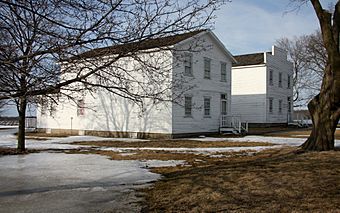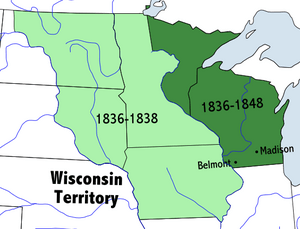First Capitol Historic Site (Wisconsin) facts for kids
Quick facts for kids |
|
|
First Capitol
|
|

The museum in 2013
|
|
| Location | N of Belmont off U.S. 151 |
|---|---|
| Nearest city | Belmont, Wisconsin |
| Area | 9.9 acres (4.0 ha) |
| Built | 1836 |
| NRHP reference No. | 70000036 |
| Added to NRHP | April 28, 1970 |
The First Capitol Historic Site is a special museum near Belmont, Wisconsin. It's a place where you can learn about the early days of Wisconsin Territory. This museum has two original buildings where the first lawmakers, called legislators, met.
The Wisconsin Historical Society now owns and runs this site. It is also listed on the National Register of Historic Places, which means it's an important historical landmark. You can visit for free!
Contents
Wisconsin's Early Days
Before 1836, the land that is now Wisconsin was part of Michigan Territory. In 1836, Michigan became a state. Then, the U.S. Congress created the Wisconsin Territory. This new territory was huge! It included parts of what are now Minnesota, Iowa, and the eastern Dakotas.
Back then, not many people lived in this large area. The total population was only about 22,000. For example, Milwaukee had fewer than 2,000 people. The city of Madison didn't even exist yet. It was just wooded hills and swamps.
Choosing a Capital City
The new Wisconsin Territory needed a place for its government to meet. This place would be called the capital. Some people who bought and sold land, called land speculators, saw a chance to make money. They hoped their land would be chosen as the capital.
One of these speculators was John Atchison. He was a businessman from Galena. In 1835, he planned a village called Belmont, Wisconsin. In 1836, he started building four public buildings there. These included a council house for lawmakers, a lodging house for them to stay, a house for the governor, and a courthouse.
These wooden buildings were built elsewhere and then shipped to Belmont. On September 9, 1836, Governor Henry Dodge announced that Belmont would be the temporary capital. This made Atchison's council house the very first capitol building. Belmont was chosen because it was in Wisconsin's lead mining area. This region had the most people at the time.
The First Legislative Session
The first meeting of Wisconsin's territorial legislature began in Belmont on October 25, 1836. Governor Dodge gave a speech. He said the goal was to set up the government and choose a permanent capital.
Many lawmakers didn't want to stay in Belmont. The lodging house was small and crowded. None of the buildings had heat or running water. Different cities like Burlington, Cassville, Fond du Lac, and Madison wanted to be the capital.
James Doty, one of the land speculators, worked hard for his "Madison City" to be chosen. He even gave buffalo robes to the cold lawmakers! After many discussions, the legislature decided. They would move the capital to Burlington for one year. Then, it would move permanently to Madison, once buildings were ready.
Setting Up the Government
When they weren't debating the capital, the lawmakers worked on setting up the government. They approved 42 new laws before they finished on December 9, 1836. These laws organized Wisconsin's government. They also created a court system and established new counties.
The legislature never met in Belmont again. They met in Burlington until the new capitol in Madison was finished. In 1838, Burlington became part of Iowa Territory. This meant the legislature had to move to Madison earlier than planned.
What Happened Next?
As Madison grew, the village of Belmont slowly became less important. Many people who had moved to Belmont left for Madison. However, the village continued to exist. In 1867, the Mineral Point Railroad was built. This caused most residents to move about three miles southeast. So, the original First Capitol building is now three miles northwest of the current town of Belmont.
After the government left, the capitol building and other structures were used as homes. Later, they became barns for animals. People even took pieces of the building as souvenirs.
In 1910, the Wisconsin Federation of Women's Clubs started a project to fix up the old council house. They finished restoring it in 1924. Later, the lodging house, which had been moved and used as a home, was brought back to its original spot. It was restored in 1956. These two buildings together became the First Capitol Historic Site.
The Wisconsin Department of Natural Resources first managed the site. In 1994, it was given to the Wisconsin Historical Society. They are now in charge of running the museum and sharing its history.
See also





